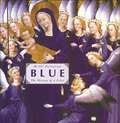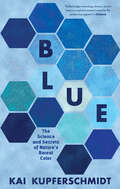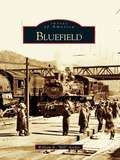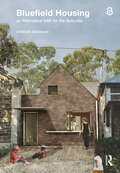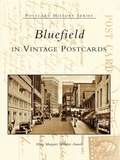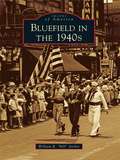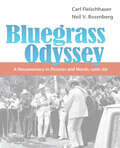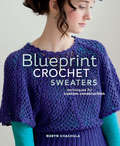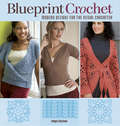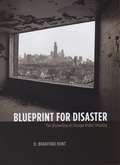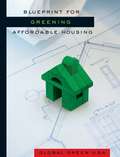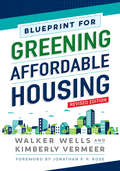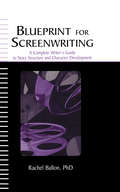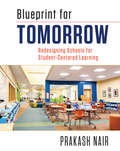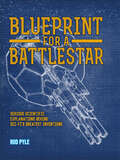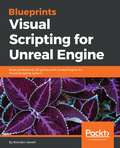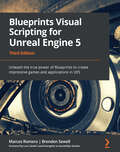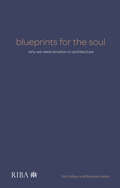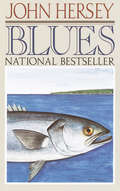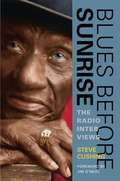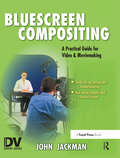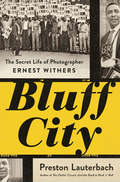- Table View
- List View
Blue: Cobalt to Cerulean in Art and Culture
by Boston Museum of Fine Arts<p>Blue, the world's favorite color, is elegantly showcased in more than 200 artworks from the collection of the Museum of Fine Arts, Boston. Representing a diversity of movements, cultures, and media that spans the ages and the globe, the objects in Blue range from ancient Egyptian jewelry and traditional Japanese prints to Impressionist paintings and indigo-dyed textiles. <p>Short essays from museum curators on the significance and symbolism of the color at various times and places provide historical context for this visual feast. With page edges dyed blue, this distinctive volume is a bijou treasure. <p>This is a fixed-format ebook, which preserves the design and layout of the original print book.</p>
Blue: The History of a Color
by Michel PastoureauA beautifully illustrated visual and cultural history of the color blue throughout the agesBlue has had a long and topsy-turvy history in the Western world. The ancient Greeks scorned it as ugly and barbaric, but most Americans and Europeans now cite it as their favorite color. In this fascinating history, the renowned medievalist Michel Pastoureau traces the changing meanings of blue from its rare appearance in prehistoric art to its international ubiquity today. Any history of color is, above all, a social history. Pastoureau investigates how the ever-changing role of blue in society has been reflected in manuscripts, stained glass, heraldry, clothing, paintings, and popular culture. Beginning with the almost total absence of blue from ancient Western art and language, the story moves to medieval Europe. As people began to associate blue with the Virgin Mary, the color became a powerful element in church decoration and symbolism. Blue gained new favor as a royal color in the twelfth century and became a formidable political and military force during the French Revolution. As blue triumphed in the modern era, new shades were created and blue became the color of romance and the blues. Finally, Pastoureau follows blue into contemporary times, when military clothing gave way to the everyday uniform of blue jeans and blue became the universal and unifying color of the Earth as seen from space.Beautifully illustrated, Blue tells the intriguing story of our favorite color and the cultures that have hated it, loved it, and made it essential to some of our greatest works of art.
Blue: The Science And Secrets Of Nature's Rarest Color
by Kai KupferschmidtWhat is it about the color blue? Blue is our favorite color globally—the darling of artists since the time of the pharaohs. So it’s startling to turn to the realms of nature and discover that “true” blue is truly rare. The sea and sky are blue, but we can’t bottle this trick of physics. And the few creatures, plants, and minerals that appear blue are almost all deceiving us. There’s no blue pigment in a blue jay—it would be brown but for how its feathers distort light. Kai Kupferschmidt has been enraptured by blue since childhood. In Blue, he invites readers on his globe-trotting quest to understand his favorite color— from Kyoto, where scientists are trying to engineer a blue rose, to Brandenburg, where conservationists hope to save the “little blue macaw.” Deep underground where blue crystals grow and miles overhead where astronauts gaze at our “blue marble” planet-wherever he finds this alluring color, it has a story to tell.
Bluefield
by William R. ArcherThe remarkable story of Bluefield represents a unique combination of geology, geography, and opportunity. Once just the confluence of a handful of family farms in southern West Virginia, Bluefield was put on the map, literally,in the 1880s, when the Norfolk & Western Railway came to town. The company's influence on the rural landscape was overwhelming, and soon, Bluefield was transformed into the center of a coal-fired universe and became a major thoroughfare for the then-thriving mining industry. Though the company--not the coal--was king in Bluefield, enterprising men and women could, and did, share in itssuccess. The city evolved into a successful supply center for the enormous network of towns that sprung up almost overnight throughout the region's coalfields. For the next 60 years, Bluefield experienced dramatic growth, enticing a diverse group of newcomers who helped to build the strong cultural heritage that continues to play a prominent role in the community to the present day.
Bluefield Housing as Alternative Infill for the Suburbs
by Damian MadiganSuburbanised cities share a common dilemma: how to transition to more densely populated and socially connected urban systems while retaining low-rise character, avoiding gentrification, and opening neighbourhoods to more diverse housing choices. Bluefield Housing offers a new land definition and co-located infill model addressing these concerns, through describing and deploying the types of ad-hoc modifications that have been undertaken in the suburbs for decades. Extending green-, brown-, and greyfield definitions, it provides a necessary middle ground between the ‘do nothing’ attitude of suburban preservation and the ‘do everything’ approach of knock-down-rebuild regeneration. An adjunct to ‘missing middle’ and subdivision densification models, with a focus on co-locating homes on small lots, Bluefield Housing presents a unified design approach to suburban infill: retrofitting original houses, retaining and enhancing landscape and urban tree canopies, and delivering additional homes as low-rise additions and backyard homes suited to the increasingly complex make-up of our households. Extensively illustrated by the author with engaging architectural design studies, Damian Madigan describes how existing quirks of suburban housing can prompt new forms of infill, explains why a new suburban densification model is not only necessary but can be made desirable for varied stakeholders, and charts a path towards the types of statutory and market triggers required to make bluefield housing achievable. Using Australian housing as an example but addressing universal concerns around neighbourhood character, demographic needs, housing diversity, dwelling flexibility, and landscape amenity, Bluefield Housing offers innovative suburban infill ideas for policy makers, planners, architects, researchers and students of housing and design studies, and for those with a stake in the future of the suburbs.
Bluefield Housing as Alternative Infill for the Suburbs
by Damian MadiganSuburbanised cities share a common dilemma: how to transition to more densely populated and socially connected urban systems while retaining low-rise character, avoiding gentrification, and opening neighbourhoods to more diverse housing choices. Bluefield Housing offers a new land definition and co-located infill model addressing these concerns, through describing and deploying the types of ad-hoc modifications that have been undertaken in the suburbs for decades. Extending green-, brown-, and greyfield definitions, it provides a necessary middle ground between the ‘do nothing’ attitude of suburban preservation and the ‘do everything’ approach of knock-down-rebuild regeneration.An adjunct to ‘missing middle’ and subdivision densification models, with a focus on co-locating homes on small lots, Bluefield Housing presents a unified design approach to suburban infill: retrofitting original houses, retaining and enhancing landscape and urban tree canopies, and delivering additional homes as low-rise additions and backyard homes suited to the increasingly complex make-up of our households.Extensively illustrated by the author with engaging architectural design studies, Damian Madigan describes how existing quirks of suburban housing can prompt new forms of infill, explains why a new suburban densification model is not only necessary but can be made desirable for varied stakeholders, and charts a path towards the types of statutory and market triggers required to make bluefield housing achievable. Using Australian housing as an example but addressing universal concerns around neighbourhood character, demographic needs, housing diversity, dwelling flexibility, and landscape amenity, Bluefield Housing offers innovative suburban infill ideas for policy makers, planners, architects, researchers and students of housing and design studies, and for those with a stake in the future of the suburbs.The Open Access version of this book, available at www.taylorfrancis.com, has been made available under a Creative Commons Attribution-Non Commercial-No Derivatives (CC-BY-NC-ND) 4.0 license.
Bluefield in Vintage Postcards
by Mary Margaret AnnettNestled at the foot of East River Mountain in the southern tip of West Virginia, Bluefield calls itself "Nature's Air-Conditioned City" and is a place of great cultural, industrial, and natural wealth. The early to mid-1900s were a booming time for the city, thanks to coal mining and the Norfolk and Western Railway. For the many people who lived in or traveled through the region during that era, postcards provided a simple and convenient way to send both personal correspondence and business communications. Today, Bluefield continues to change and evolve but maintains a strong sense of history, with many of its buildings and homes listed on the National Register of Historic Places.
Bluefield in the 1940s
by William R. ArcherAlmost every American city enjoys a magical time in history when all the tumblers of fate, luck, hard work, and good fortune seem to fall into place, and the city enjoys a golden era. The 1940s were just such a time in the city of Bluefield. At the dawn of the decade, the United States was on the verge of entering the greatest war the world has ever known, and the coal that flowed through Norfolk and Western Railway's Bluefield yard was destined to fuel an Allied victory. But there is so much more than war and coal at the heart of Bluefield's story. The 1940s were a time of inspiration for men like Nobel laureate John F. Nash Jr., a time of artistic discovery for men like Joseph Dodd of Bluefield State College, a time of valor and heroism for Congressional Medal of Honor recipient S.Sgt. Junior Spurrier, and a period of success in business, arts, and professional fields for hundreds of Bluefield's sons and daughters.
Bluegrass Odyssey: A Documentary in Pictures and Words, 1966-86 (Music in American Life)
by Neil V RosenbergThe fruit of four decades of collaboration between bluegrass music’s premier photographer and premier historian, Bluegrass Odyssey is a satisfying and visually alluring journey into the heart of a truly American music. Combining more than two hundred of Carl Fleischhauer’s photographs with Neil V. Rosenberg’s expert commentary, this elegant visual documentary captures the music-making with the culture and community that foster it.
Blueprint Crochet Sweaters: Techniques for Custom Construction
by Robyn ChachulaLearn the must-have basics of sweater construction and ways to achieve better-fitting garments! Best-selling author of Blueprint Crochet, Robyn Chachula presents an approachable resource on the basics of crochet design. This friendly introduction to sweater and garment construction will give you a deeper understanding of working with crochet and help you make better-fitting garments in the process. In this collection of 16 patterns, Robyn focuses on four basic garment types and their variations--"classic" construction (including raglan, drop-sleeve, and side-saddle sleeve); unique construction (side-to-side or from the bottom up, around the shoulder, and back down); motif construction; and top-down (both round and raglan types). The perfect introduction to the building blocks of crochet sweater construction, Blueprint Crochet Sweaters breaks down intimidating garment design into easily digestible parts, offering a deeper appreciation and understanding of how to create projects that reflect your own personal style.
Blueprint Crochet: Modern Designs for the Visual Crocheter
by Robyn ChachulaUsing graphic illustrations and clear guidelines, this straightforward crochet resource is essential for the visual crafter - anyone who understands maps better than verbal directions, and images better than basic step-by-step instructions. Covering a wide range of skill levels, it introduces the universal symbol language of crochet to newcomers, while also satisfying the need for intermediate level patterns. Each crochet design is broken down stitch-by-stitch in a diagram format so that visual learners can see, as well as read, each step. With contemporary designs from trendy to classic, each project offers a fresh take on crochet, providing modern patterns for purses, necklaces, belts, dresses, shawls, and more.
Blueprint Reading for Welders and Fitters: programmed instructions
by HobartThis program is designed to give you a thorough understanding of blueprints such that you can interpret exactly what a designer requires.
Blueprint for Disaster: The Unraveling of Chicago Public Housing
by D. Bradford HuntNow considered a dysfunctional mess, Chicago's public housing projects once had long waiting lists of would-be residents hoping to leave the slums behind. So what went wrong? To answer this complicated question, D. Bradford Hunt traces public housing's history in Chicago from its New Deal roots through current mayor Richard M. Daley's Plan for Transformation. In the process, he chronicles the Chicago Housing Authority's own transformation from the city's most progressive government agency to its largest slumlord. Challenging explanations that attribute the projects' decline primarily to racial discrimination and real estate interests, Hunt argues that well-intentioned but misguided policy decisions- ranging from design choices to maintenance contracts- also paved the road to failure. Moreover, administrators who fully understood the potential drawbacks did not try to halt such deeply flawed projects as Cabrini-Green and the Robert Taylor Homes. These massive high-rise complexes housed unprecedented numbers of children but relatively few adults, engendering disorder that pushed out the working class and, consequently, the rents needed to maintain the buildings. The resulting combination of fiscal crisis, managerial incompetence, and social unrest plunged the CHA into a quagmire from which it is still struggling to emerge. Blueprint for Disaster, then,is an urgent reminder of the havoc poorly conceived policy can wreak on our most vulnerable citizens.
Blueprint for Greening Affordable Housing
by Global Green UsaBlueprint for Green Affordable Housing is a guide for housing developers, advocates, public agency staff, and the financial community that offers specific guidance on incorporating green building strategies into the design, construction, and operation of affordable housing developments. A completely revised and expanded second edition of the groundbreaking 1999 publication, this new book focuses on topics of specific relevance to affordable housing including: *how green building adds value to affordable housing *the integrated design process *best practices in green design for affordable housing *green operations and maintenance *innovative funding and finance *emerging programs, partnerships, and policies Edited by national green affordable housing expert Walker Wells and featuring a foreword by Matt Petersen, president and chief executive officer of Global Green USA, the book presents 12 case studies of model developments and projects, including rental, home ownership, special needs, senior, self-help, and co-housing from around the United States. Each case study describes the unique green features of the development, discusses how they were successfully incorporated, considers the project's financing and savings associated with the green measures, and outlines lessons learned. Blueprint for Green Affordable Housing is the first book of its kind to present information regarding green building that is specifically tailored to the affordable housing development community.
Blueprint for Greening Affordable Housing, Revised Edition
by Walker Wells Kimberly VermeerBlueprint for Greening Affordable Housing is the most comprehensive resource on how green building principles can be incorporated into affordable housing design, construction, and operation. In this fully revised edition, Walker Wells and Kimberly Vermeer capture the rapid evolution of green building practices and make a compelling case for integrating green building in affordable housing. The Blueprint offers guidance on innovative practices, green building certifications for affordable housing, and the latest financing strategies. The completely new case studies share detailed insights on how the many elements of a green building are incorporated into different housing types and locations. Every affordable housing project can achieve the fundamentals of good green building design. The Blueprint gives project teams what they need to push for excellence.
Blueprint for Screenwriting: A Complete Writer's Guide to Story Structure and Character Development
by Rachel BallonBlueprint for Screenwriting demystifies the writing process by developing a "blueprint" for writers to follow for each new screenplay--from original concept to completed script. Author and international script consultant Dr. Rachel Ballon explores the writing craft and emphasizes creativity in the writing process. She blends her expertise in script analysis and writing coaching with her personal experience as a screenwriter to help writers construct their stories and characters.Starting with the story's framework, Dr. Ballon helps readers to understand the key "building blocks" of story structure and character development, including characters' emotional and psychological states, story conflicts, and scene and act structure. She also covers the essential components in the script writing process, such as outlines, script treatments, synopses, and formats. Dr. Ballon devotes a chapter to overcoming writer's block--the writer's greatest obstacle--and offers guidance for taking the next steps once a script is completed.A practical tool for any writer, this distinctive resource:*offers a blueprint for writers to follow, breaking the writing process down into specific, easy-to-follow steps;*stresses the psychology of the characters as well as that of the writer; and*offers first-hand knowledge of the screenwriting process and gives practical advice for completing and marketing scripts.With its unique and insightful approach to the writing process, this book will be indispensable for scriptwriters, fiction writers, and professional writers, and it will serve as a useful text in screenwriting courses.
Blueprint for Tomorrow: Redesigning Schools for Student-Centered Learning
by Prakash NairThe United States has about $2 trillion tied up in aging school facilities. School districts throughout the country spend about $12 billion every year keeping this infrastructure going. Yet almost all of the new money we pour into school facilities reinforces an existing—and obsolete—model of schooling. In Blueprint for Tomorrow, Prakash Nair—one of the world&’s leading school designers—explores the hidden messages that our school facilities and classrooms convey and advocates for the &“alignment&” of the design of places in which we teach and learn with twenty-first-century learning goals.Blueprint for Tomorrow provides simple, affordable, and versatile ideas for adapting or redesigning school spaces to support student-centered learning. In particular, the author focuses on ways to use current spending to modify existing spaces, and explains which kinds of adaptations offer the biggest return in terms of student learning. The book is organized by area—from classrooms to cafeterias—and is richly illustrated throughout, including &“before and after&” features, &“smart idea&” sidebars, and &“do now&” suggestions for practical first steps. It outlines key principles for designing spaces that support today&’s learning needs and includes tools to help educators evaluate the educational effectiveness of their own spaces.Blueprint for Tomorrow will open educators&’ eyes to the ways that architecture and learning are entwined and will challenge them to rethink the ways they teach and work together.
Blueprint for a Battlestar: Serious Scientific Explanations Behind Sci-Fi's Greatest Inventions
by Rod Pyle“An enjoyable source of information on a wide variety of real or imagined technological marvels of the space age.” —National Space SocietyThis beautifully illustrated pop science book answers the enduring questions raised by science fiction, such as: Do hoverboards really exist, how can you bring a dinosaur back to life and can we really travel in time and space.Packed with stunning images, including seventy-five illustrations created exclusively for this book, Blueprint for a Battlestar takes twenty-five remarkable and memorable technologies from the world of sci-fi, from Star Wars and The Matrix to Ironman and The Terminator. Each concept will be explained and dissected to reveal the real science behind it. Some are boldly obvious—such as the Death Star and exoskeletons—and some less so (think bio-ports or cloaking devices). All are fascinating and will make wonderful explorations into the science of the future as we understand it today.“This is dream fuel for aspiring STEM students of all sorts. Blueprint for a Battlestar is a gateway drug for brainstorming that could change the world.” —Seattle Book Review“Will take readers on a fact-finding mission where the science is explained and the fiction just may become reality. Can it really work? For the sake of all those young engineers out there dreaming of a future filled with massive battlestars stretching far across the galaxy, we can only hope.” —Amazing Stories Magazine“A fun book that offers serious exploration of some of the technology that could be common place in the not too distant future.” —The Review Graveyard
Blueprints Visual Scripting for Unreal Engine
by Brenden Sewell<P><P>Blueprints Visual Scripting for Unreal Engine is a step-by-step approach to building a fully functional game, one system at a time. Starting with a basic First Person Shooter template, each chapter will extend the prototype to create an increasingly complex and robust game experience. You will progress from creating basic shooting mechanics to gradually more complex systems that will generate user interface elements and intelligent enemy behavior. Focusing on universally applicable skills, the expertise you will develop in utilizing Blueprints can translate to other types of genres. <P><P>By the time you finish the book, you will have a fully functional First Person Shooter game and the skills necessary to expand on the game to develop an entertaining, memorable experience for your players. <P><P>From making customizations to player movement to creating new AI and game mechanics from scratch, you will discover everything you need to know to get started with game development using Blueprints and Unreal Engine 4.
Blueprints Visual Scripting for Unreal Engine 5: Unleash the true power of Blueprints to create impressive games and applications in UE5
by Marcos Romero Brenden SewellExplore the faster way to build games using UE5 Blueprints using this practical guide with key images printed in colorKey FeaturesDesign a fully functional game in UE5 without writing a single line of codeImplement visual scripting to develop gameplay mechanics, UI, visual effects, VR, and artificial intelligenceDeploy your game on multiple platforms and share it with the worldBook DescriptionUnreal Engine's Blueprint visual scripting system enables designers to script their games and programmers to create base elements that can be extended by designers. With this book, you'll explore all the features of the Blueprint Editor, along with expert tips, shortcuts, and best practices. The book guides you through using variables, macros, and functions, and helps you learn about object-oriented programming (OOP). You'll discover the Gameplay Framework and advance to learning how Blueprint Communication allows one Blueprint to access information from another Blueprint. Later chapters focus on building a fully functional game step by step. You'll start with a basic first-person shooter (FPS) template, and each chapter will build on the prototype to create an increasingly complex and robust game experience. You'll then progress from creating basic shooting mechanics to more complex systems such as user interface elements and intelligent enemy behavior. The book demonstrates how to use arrays, maps, enums, and vector operations and introduces the elements needed for VR game development. In the final chapters, you’ll learn how to implement procedural generation and create a product configurator. By the end of this book, you'll have learned how to build a fully functional game and have the skills required to develop an entertaining experience for your audience.What you will learnUnderstand programming concepts in BlueprintsCreate prototypes and iterate new game mechanics rapidlyBuild user interface elements and interactive menusUse advanced Blueprint nodes to manage the complexity of a gameExplore all the features of the Blueprint editor, such as the Components tab, Viewport, and Event GraphGet to grips with OOP concepts and explore the Gameplay FrameworkWork with virtual reality development in UE BlueprintImplement procedural generation and create a product configuratorWho this book is forThis book is for anyone interested in developing games or applications with UE5. Although basic knowledge of Windows OS is required, experience in programming or UE5 is not necessary.
Blueprints for the Soul: Why we need emotion in architecture
by Nick Moss Barbara IddonYou know that something is wrong, even if you can't quite put your finger on it. This book tells you why, and how to solve it.There is a lack of beauty and emotion in our built environment. The visual patterns in nature that instinctively satisfy us are being obliterated from our surroundings, which have become progressively monolithic and featureless. We don't question why nature matters. We implicitly understand that nature feeds us metaphorically as well as literally. Nowhere was this more evident than in the lockdowns endured during the earlier stages of the Covid pandemic, where city dwellers became ever more desperate to leave the urban sprawl and get into the green. Human beings are highly attuned to the sensory inputs of the natural environment. On the large scale, we respond to the sight of a captivating view. On the small scale, our senses can come alive at the sight of richly painted flowers, the pungent green smell of freshly cut grass or the song of a blackbird.Our response to beauty, to the right things in the right place, is part of what makes life worth living.Over the last century, a majority of the buildings we see, work in and live in have become increasingly monolithic, functional and featureless inside and out. They are anti-nature, or put another way, anti-human. The power of architecture to inspire, move and delight has been under attack for many years and for many different reasons. But emotion in architecture matters because it satisfies and encompasses the human condition and offers a glimpse into the transcendent. Emotion in architecture allow us to appreciate, aspire and connect.When our natural capacities for aesthetic appreciation are quashed, instead of feeling inspired, we feel imprisoned. Instead of feeling uplifted, we feel depressed. Instead of feeling liberated, we feel oppressed. Instead of feeling connected, we feel isolated. Bad buildings, like undiagnosed high blood pressure or type two diabetes, silently rob us of energy, health and well-being.This is not about the lofty projects that academics and critics are so keen to discuss. It's about the buildings we see every day as we go about our business, the ones we live and work in: houses and shops, offices and cafes, schools and centres. It's about the fact that so many of them are letting us down.
Blues
by John HerseyFrom the revered Pulitzer Prize winning journalist and writer, comes his National Bestseller on one of the world’s oldest and most popular activities, fishing. Presented in narrative form as a conversation between a Fisherman and the Stranger, Hersey draws upon his own experiences and passion as the fisherman reflects on the age old sport, offering his own insights and thoughts. From the depths of the ocean to the creatures near the shore, Hersey perfectly answers why fishing has been such an integral part of humanity. “Almost no one has answered “why fish?” better than Mr. Hersey . . . what he does best of all is evoke wonder.”—New York Times Book Review“Blues is, of course, about much more than the pleasures and techniqu3es of fishing; it is, as Fisherman tells Stranger, about interconnections—the ties between mankind and the natural world, among others.”—The New Yorker“Wonderful . . . He gives us a rich and vivid sense of ocean life. . . . The whole thing is as stately as a minuet, and as graceful.”—Chicago Sun-Times
Blues Before Sunrise: The Radio Interviews
by Steve Cushing Jim O'NealThis collection assembles the best interviews from Steve Cushing's long-running radio program Blues Before Sunrise, the nationally syndicated, award-winning program focusing on vintage blues and R&B. As both an observer and performer, Cushing has been involved with the blues scene in Chicago for decades. His candid, colorful interviews with prominent blues players, producers, and deejays reveal the behind-the-scenes world of the formative years of recorded blues. Many of these oral histories detail the careers of lesser-known but greatly influential blues performers and promoters. The book focuses in particular on pre-World War II blues singers, performers active in 1950s Chicago, and nonperformers who contributed to the early blues world. Interviewees include Alberta Hunter, one of the earliest African American singers to transition from Chicago's Bronzeville nightlife to the international spotlight, and Ralph Bass, one of the greatest R&B producers of his era. Blues expert, writer, record producer, and cofounder of Living Blues Magazine Jim O'Neal provides the book's foreword.
Bluescreen Compositing: A Practical Guide for Video & Moviemaking (Dv Expert Ser.)
by John JackmanMaster the art and technique of blue and greenscreen compositing with this comprehensive how-to course in creating effective and realistic composited scenes in video formats. You get clear, understandable explanations of the different types of keying techniques and how they work, including real-world examples and tutorials. Topics include setting up a greenscreen studio, how to light the screen effectively, how to light the talent or foreground material, and matching lighting to the composited background plate. Complete tutorials of each of the major software keyers walk you through the process for creating a clean and accurate composite.
Bluff City: The Secret Life Of Photographer Ernest Withers
by Preston LauterbachThe little-known story of an iconic photographer, whose work captured—and influenced—a critical moment in American history. Who was Ernest Withers? Most Americans may not know the name, but they do know his photographs. Withers took some of the most legendary images of the 1950s and ’60s: Martin Luther King, Jr., riding a newly integrated bus in Montgomery, Alabama; Emmett Till’s uncle pointing an accusatory finger across the courtroom at one of his nephew’s killers; scores of African-American protestors, carrying a forest of signs reading "I am a man." But while he enjoyed unparalleled access to the inner workings of the civil rights movement, Withers was working as an informant for the FBI. In this gripping narrative history, Preston Lauterbach examines the complicated political and economic forces that informed Withers’s seeming betrayal of the people he photographed. Withers traversed disparate worlds, from Black Power meetings to raucous Memphis nightclubs where Elvis brushed shoulders with B.B. King. He had a gift for capturing both dramatic historic moments and intimate emotional ones, and it may have been this attention to nuance that made Withers both a brilliant photographer and an essential asset to the FBI. Written with similar nuance, Bluff City culminates with a riveting account of the 1968 riot that ended in violence just a few days before Dr. King’s death. Brimming with new information and featuring previously unpublished and rare photographs from the Withers archive not seen in over fifty years, Bluff City grapples with the legacy of a man whose actions—and artistry—make him an enigmatic and fascinating American figure.

